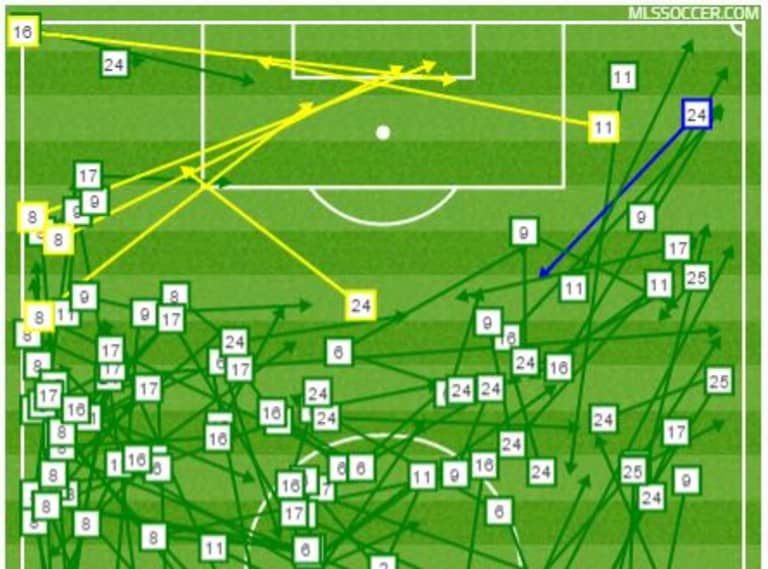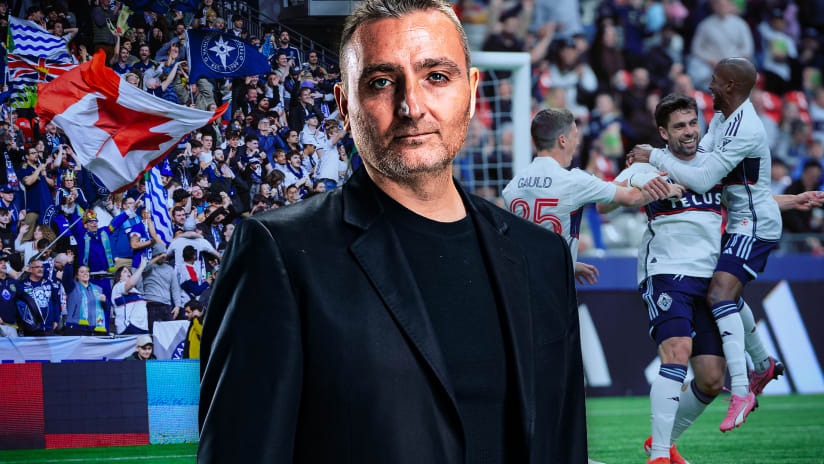Possession matters, except when it doesn't.
In the first half of New England's 2-1 win over the San Jose Earthquakes on Saturday afternoon the Quakes won the possession battle, holding onto 51 percent of the ball. Here's what their completed passes in the attacking half looked like:

Yellow lines are "key passes" that lead to shots (go ahead and click the image, which is hyperlinked to the Opta events map – you can then play around with it yourself and see what you see).
Here's what the Revs did with their 49 percent of the ball:

Green for a successful pass, yellow for a key pass, blue for an assist. The Revs took 14 shots in the first half, and the Quakes took just three. Over 50 percent of New England's completed passes in the first 45 came in in San Jose's defensive half; for the Quakes, that number was down around 35 percent.
Other high pressure teams – notably Sporting KC since 2011, but I'll also throw in the 2013 Timbers and 2014 RSL – marry their front-foot defense with a methodical patience on the ball. New England aren't like that.
The Revs break all the models we're used to using when talking about posession. They are skillful and creative, but don't love to hold the ball in the midfield. They are a high pressure team that would rather just keep that pressure on for all 90 rather than trying to kill the game off by knocking it around. They lead the league by miles in passes attempted and completed in the final third, but are middle of the pack in pretty much every other possession metric.
And why not? There's not a ton of data that says playing defensively with a late lead is a great strategy, and high pressure produces goals. It did for Kelyn Rowe in the game's opener (Watch HERE).
Rowe's goal was the direct result of a turnover from left back Shaun Francis, who was targeted every time he got on the ball. Jean-Baptiste Pierazzi was the other Quake given a torrid time in the first half - watch his slow read and overcommitment HERE – so Dom Kinnear was compelled to make a couple of changes at the break.
Thing is, he didn't take off the two guys who were so obviously struggling. Instead he made one straight swap on the wing (Shea Salinas for Sanna Nyassi) and brought in center forward Adam Jahn for central midfielder JJ Koval:
That's a clinic. Too many people think "use a target forward to break a high press" means "boot it long!" That is occasionally an acceptable option, but smart, cohesive team movement trumps hoof-and-hope any day. Bringing on a target forward like Jahn ended up pushing the Revs central defense deeper, which thus created space between the lines for the Quakes to actually play through the press that had stifled them so in the first half.
San Jose were a better team in the second, and certainly more dangerous. And guess what? They lost the possession battle, 55% to 45% even though they mostly evened out the game.
These are lessons of teams have learned over the years, ones that bear repeating here:
- More possession does not always equal better possession
- Sometimes if you want your midfield to play better, you have to add a forward
- Sometimes if you want your forwards to be more dangerous, you have to drop one and add a midfielder













